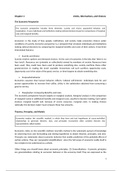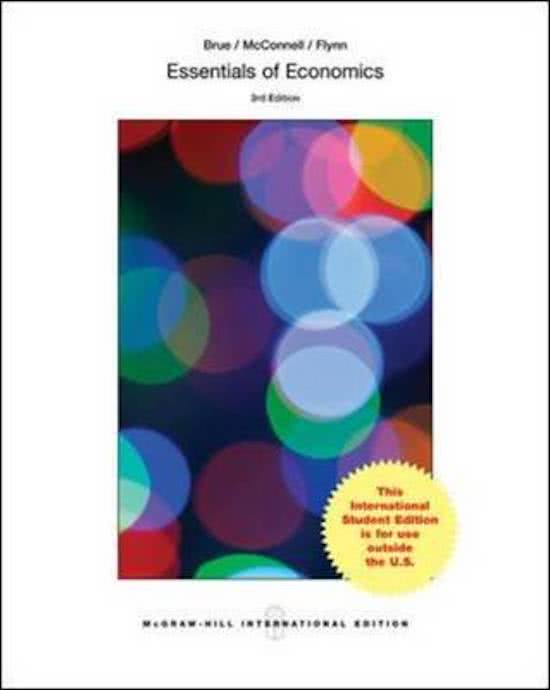Chapter 1 Limits, Alternatives, and Choices
The Economic Perspective
The economic perspec ve includes three elements: scarcity and choice, purposeful behavior, and
marginalism. It sees individuals and ins tu ons making ra onal decisions based on comparisons of marginal
costs and marginal benefits.
Economics is the study of how people, ins tu ons, and society make economics choices under
condi ons of scarcity. Economic perspective is a viewpoint that envisions individuals and ins tu ons
making ra onal decisions by comparing the marginal benefits and costs of their ac ons. It has three
interrelated features:
➢ Scarcity and Choice
Scarcity restricts op ons and demands choices. At the core of economics is the idea that ‘there is no
free lunch’. Resources are (privately or collec vely) owned by members of society. Resources have
been used, they could have been used to produce something else, society sacrifices those other
goods/services in making the lunch available. Economists call such sacrifices opportunity costs.
Opportunity cost is the value of the good, service, or me forgone to obtain something else.
➢ Purposeful behavior
Economics assumes that human behavior reflects ‘ra onal self-interest’. Individuals look for and
pursue opportuni es to increase their u lity. Utility is the sa sfac on obtained from consuming a
good or service.
➢ Marginalism: Comparing Benefits and Costs
The economic perspec ve focuses largely on marginal analysis. Marginal analysis is the comparison
of marginal (extra or addi onal) benefits and marginal costs, usually for decision making. Each op on
involves marginal benefit and, because of scarce resources, marginal costs. In making choices
ra onally, the decision maker must compare those two amounts.
Theories, Principles, and Models
Economist employ the scien fic method, in which they form and test hypotheses of cause-and-effect
rela onships to generate theories, laws, and principles. Economists o en combine theories into
representa ons called models.
Economics relies on the scien fic method. Scientific method is the systema c pursuit of knowledge
by observing facts and formula ng and tes ng hypotheses to obtain theories, principles, and laws.
Principles are statements about economic behavior that enable predic on of the probable effects of
certain ac ons. They are ‘purposeful simplifica ons’, since the full scope of economic reality itself is
too complex to be understood as a whole.
Other things you should know about economic principles: (1) Generaliza ons - Economic principles
are generaliza ons rela ng to economic behavior or the economy itself. They are expressed as the
1
,tendencies of typical or average consumers/workers/businesses. (2) Other-things-equal assump on -
The other-things-equal assumption is the assump on that factors other than those being considered
do not change. (3) Graphical expression - Many economic models are expressed graphically.
Microeconomics and Macroeconomics
Microeconomics examines the decision making of specific economic units or ins tu ons. Macroeconomics
looks at the economy as a whole or its major aggregates.
Economists develop economic principles and models at two levels.
➢ Microeconomics
Microeconomics is the part of economics concerned with individual decision-making units, such as a
consumer, a worker, or a business firm.
➢ Macroeconomics
Macroeconomics is the part of economics concerned with the economy as a whole or major
aggregates/components of the economy. Aggregate is a collec on of specific economic units treated
as if they were one unit (fe. consumers).
Individual’s Economic Problem
Individuals face an economic problem. Because their wants exceeds their incomes, they must decide what to
purchase and what to forgo.
It is clear from our previous discussion that both individuals and society face an economic problem.
Economic problem is the need for individuals and society to make choices because wants exceed
means.
We all have a finite amount of income, even the wealthiest among us. But most people have virtually
unlimited wants. Because we have only limited income but seemingly insa able wants, it is in our
self-interest to economize: to pick and choose goods and services that maximize our sa sfac on,
given the limita ons we face.
Graphically, a budget line (or budget constraint) illustrates the economic problem for individuals. The line
shows the various combina ons of two products that a consumer can purchase with a specific money
income, given the prices of two products.
An individual’s economic problem can be depicted as an budget line. Budget line is a line that shows
various combina ons of two products a consumer can purchase with a specific money income, given
the products’ price.
2
,The budget line illustrates several ideas: (1) All the combina ons on or inside the line are a ainable.
All combina ons beyond the line are una ainable. (2) The budget line illustrates the idea of
trade-offs arising from limited income. To obtain 1 T-shirt you have to give up 2 movies (opportunity
cost). The straight-line, with its constant slope, indicates constant opportunity cost. Constant
opportunity cost is an opportunity cost that remains the same as consumers shi purchases from one
product to another along a straight-line budget line. (3) Limited income forces people to choose what
to buy and what to forgo to fulfill wants. You will evaluate marginal benefits and marginal costs to
make choices that maximizes your sa sfac on. (4) The loca on of the budget line varies with money
income. An increase in money income shi s the line to the right; a decrease in money income shi s
the line to the le .
Society’s Economic Problem
Society also faces an economic problem. Societal wants exceed the available resources necessary to fulfill
them. Society therefore must decide what to produce and what to forgo.
Economic resources are inputs into the produc on process and can be classified as land, labor, capital, and
entrepreneurial ability. Economic resources are also known as factors of produc on or inputs.
Society’s economic resources are limited or scarce. Economic resources are the land, labor, capital,
and entrepreneurial ability used in the produc on of goods and services.
● Land is the natural resources (‘gi s of nature’) used to produce goods and services.
● Labor is the physical and mental talents and efforts of people used to produce goods and
services.
● Capital is human-made resources (buildings, machinery, and equipment) used to produce
goods and services. Investment is the purchase of capital resources. Capital goods differ from
consumer goods because consumer goods sa sfy wants directly, while capital goods do so
indirectly by aiding the produc on of consumer goods.
● Entrepreneurial ability is the human talent that combines the other resources to produce a
product, make strategic decisions, and bear risks.
3
, Production Possibilities Model
Society’s economic problem can be illustrated through produc on possibili es analysis. Produc on
possibili es tables and curves show the different combina ons of goods and services that can be produced
in a fully employed economy, assuming that resource quan ty, resource quality, and technology are fixed.
Society uses its scarce resources to produce goods and services. The alterna ves and choices it faces
can be best understood through a macroeconomic model of produc on possibili es.
We assume:
1. Full employment - The economy is employing all of its available resources.
2. Fixed resources - The quan ty and quality of the factors of produc on are fixed.
3. Fixed technology - The state of technology (the methods used to produce output) is constant.
4. Two goods - The economy is producing only two goods: food products and manufacturing
equipment.
Food products symbolize consumer goods. Consumer goods are products/services that directly
sa sfy consumer wants. Manufacturing equipment symbolize capital goods. Capital goods are items
that are used to produce other goods and therefore do not directly sa sfy consumer wants.
An economy that is fully employed and thus opera ng on its produc on possibili es curve must sacrifice the
output of some types of goods and services to increase the produc on of others. The gain of one type of
good or service is always accompanied by an opportunity cost in the form of the loss of some of the other
type.
Production possibilities curve is a curve showing the different combina on of goods and services that
can be produced in a fully employed economy, assuming the available supplies of resources and
technology are fixed.
4






